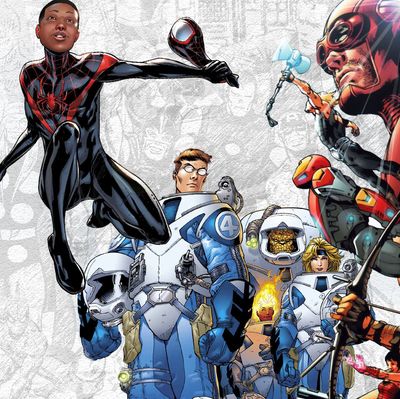
A reboot is a delicate thing. When a once-profitable franchise of characters becomes stale, outdated, or overly complex, there will always be voices calling for the slate to be wiped clean: to take the characters back to their basics, retell their origin stories, make them contemporary. But all too often, those rebooting efforts are laughable, pandering failures. Ultimate Marvel was the rare exception. It was a compendium of stories that saved the company that launched it, revolutionized the comics medium, and became the foundation of the multi-billion-dollar Marvel cinematic empire.
It began as a Hail Mary maneuver. Ultimate Marvel was a publishing experiment launched by Marvel Comics — the superhero-comics company that had invented the Avengers, Spider-Man, the X-Men, and countless other icons — during its darkest hour. The idea was simple: Launch various comics series where all the famous Marvel characters are young again and just starting their superhero careers in the modern day. Give the series flashy titles like Ultimate Spider-Man and Ultimate X-Men and make sure no reader will have to go back and read decades’ worth of comics to understand what’s going on. Return to core principles. Make these icons fresh again.
There were many reasons the initiative could have failed, but it instead succeeded beyond its creators’ wildest dreams. Indeed, the world of Marvel movie adaptations — including this summer’s megahit Avengers sequel and upcoming Fantastic Four — owe more to the Ultimate imprint than any other single Marvel Comics initiative. And yet, 15 years after the Ultimate line’s birth, Marvel just killed it. Last week, a five-issue miniseries called Ultimate End debuted, and when it’s done, there will be no more Ultimate Marvel. There is little mourning, even among die-hard comics fans who once loved the imprint.
What happened? Why dispose of something so successful? To find the answers, we must look at the secret history of Ultimate Marvel. It’s a story of desperate ambition, shocking triumph, and fevered imagination. But it’s also a cautionary tale: one about pushing limits too far, holding on too long, and learning to accept the forces of entropy. Here, then, is the tale of Ultimate Marvel, one of entertainment’s greatest reboots — but also living proof that all reboots can become victims of their own success.
*****
“When I got hired, I literally thought I was going to be writing one of the last — if not the last — Marvel comics,” says now-legendary comics writer Brian Michael Bendis, who wrote the first comic of the Ultimate line and will be writing the final one, too. When he wrote that first issue in 2000, the once-venerable Marvel was in chaos. “It’s so the opposite now, that people don’t even know.”
Here’s some context to understand the red-alert disaster the comics industry had become by the eve of the Ultimate experiment. In 1993, annual combined comics sales across all publishers had been close to a billion dollars; in 1999, that same number was a microscopic $270 million. In 1989, Batman was the most-talked-about movie in America; by 1999, the disastrous Batman & Robin had squirted a stink on the very idea of a cinematic comic-book adaptation. Marvel especially was feeling the burn: It went through a humiliating Chapter 11 bankruptcy in the late ‘90s, saw wave after wave of layoffs, and executive leadership was shuffled every few weeks. In 1999, after years of comics-publishing dominance, the company lost its top spot in industry market share and watched its rival, DC Comics, take the throne.
There was a wide array of causes for Marvel’s woes — the collapse of a comics-as-collectible-items bubble and multiple defections by top artists, for example. But one ailment was obvious to any brand-new reader who bought a Marvel comic for the first time: There was so much backstory that the stories were almost incomprehensible.
Ever since Marvel’s first comic in 1939, nearly every superhero story it published had to fit into a shared, ongoing universe of characters and events. There was some fudging of time frames (Spider-Man was introduced as a teenager in 1962, and by 1999, he was only in his 30s or so), but every story was built on the back of every previous story, and all stories were interconnected: Iron Man might talk about some battle that had occurred in X-Men, Mr. Fantastic would remember things that happened in comics published 20 years prior, and there were regular companywide “crossover events,” where all the heroes would fight the same evil at the same time.
If you’re confused by that description, don’t worry — so was everyone else. Sixty years of continuity had set an insanely high bar for understanding what was happening in a Marvel comic, even if you were a die-hard fan. (To be fair: DC also had this problem.) What’s more, everything in Marvel looked and sounded behind-the-times. In a world where geek audiences were flocking to watch the sleek, leather-clad, hip (by 1999 standards) action of The Matrix, Marvel’s stories were alienatingly ridiculous. In the pages of Marvel’s flailing comics series, you might see the Avengers — wearing uniforms of clownish purple or baby-blue — fighting wooden-dialogued villains with names like Kang the Conqueror and Lord Templar. Spider-Man was a married stiff who spent years trying to solve the mystery of whether or not he was a clone. And the characters were all so old: The phenomenon of ongoing continuity meant the original X-Men hadn’t been teenagers for decades. A pop-culture empire lives and dies on young-adult interest, and Marvel’s was fast receding.
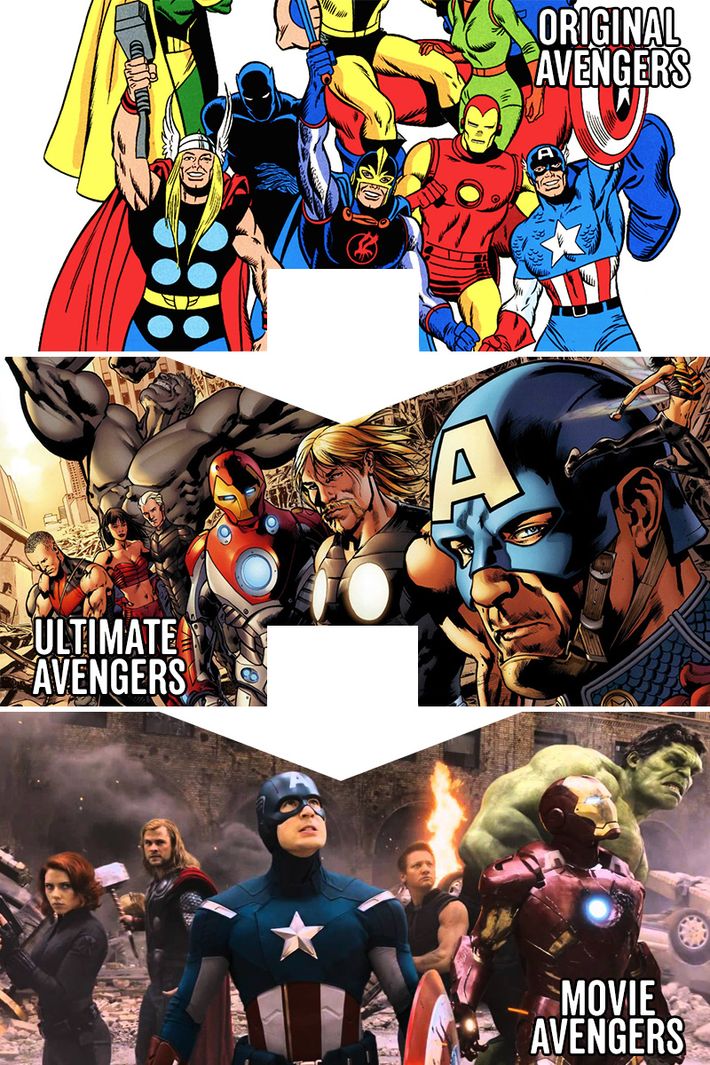
Enter Bill Jemas. He was a relative outsider to the comics world (he’d gotten his law degree from Harvard before spending most of his career in the collectible-trading-card industry) who was put in charge of Marvel’s editorial direction in 2000. He hated what Marvel had become: a place that was “publishing stories that were all but impossible for teens to read — and unaffordable, to boot,” as he put it to me. But Jemas had an idea, born of a suggestion he says the CEO of Wizard, a comics-industry magazine, gave to him: “turn our middle-aging heroes back into teens.” In other words, he wanted to launch a reboot.
Of course, that could have been a suicidally horrible idea if executed poorly. (Imagine some 55-year-old veteran comics writer penning a Spider-Man title where Peter Parker wears a backwards baseball cap and yells “Bodacious!” after hitting Green Goblin with a skateboard.) The company needed fresh and relatively young talent writing such stories. Luckily, Marvel had a charming, freshly minted editor-in-chief with great respect in the indie-comics world: Joe Quesada, who quickly sought out writers from outside the Marvel family. Quesada (who could not be reached for an interview) also had the virtue of being a devoted company man: Jemas recalled that Quesada would’ve preferred to “tell stories about new heroes, e.g., Peter Parker’s nephew,” rather than do a reboot, but went along with the Jemas plan nonetheless.
While Quesada was headhunting, Jemas struggled to find the right way to conceptualize his new initiative (at that time tentatively titled “Ground Zero,” a name that fortuitously was abandoned). Comics companies had tried to jettison decades of storytelling before, and it usually ended in failure. Do you create a story where some cosmic event resets the clock on 60 years of continuity? DC had done that with its “Zero Hour” event in 1994, and it only ended up making everything more confusing for readers. Would you send your best heroes into another dimension, where they were somehow rejuvenated? Marvel did that with its “Heroes Reborn” event in 1996, which drained the company’s finances, received abysmal reviews, and soured relations between editors and creators.
Jemas opted for an extremely simple premise: There would be a new Spider-Man series and a new X-Men series, in which all the characters were still young. That’s it: No explanations about why, no complicated in-continuity sci-fi justifications about interdimensional travel, nothing. Just stories where the most basic archetypes were in place — Peter Parker getting spiderlike powers after a spider bites him, the X-Men being superpowered mutants in a world that fears and hates them, Wolverine being grumpy, and so on — but where the characters were all starting out in the world of 2000, beginning a new continuity.
And Jemas had a firewall against failure, too: Marvel would continue to publish the existing Spider-Man and X-Men series, the ones with hundreds of issues of complicated, old continuity. They — the so-called “mainstream” Marvel series — would be unaffected. The rebooted tales would simply exist in another fictional universe — and if those stories didn’t sell, Marvel could just cancel them without affecting existing mainstream continuity. There was no reason not to give it a try. Jemas and Quesada don’t recall how they hit upon the name “Ultimate” for the branding, but it came up at some point and stuck in their minds. They aimed to launch Ultimate Spider-Man and Ultimate X-Men by year’s end. But as the months wore on, the talent hunt was getting dire. “Honestly, I kissed a lot of frogs,” Jemas recalled.
That’s when Quesada made a fateful phone call to Brian Michael Bendis. At the time, Bendis was a struggling freelance indie-comics writer/artist whose biggest claim to fame was a mediocre-selling historical drama about a serial killer from the 1930s. “My normal was, I’ll sell 2,000 copies of a comic, get a check for $400, and then hustle to do caricatures all weekend to make some real money,” Bendis recalled with a laugh. So he was shocked when Quesada got in touch and told Bendis to pitch a back-to-basics Spidey story where Peter Parker was a teen and everything was a blank slate. Apparently, one of the previous auditionees had written a word-for-word adaptation of Spider-Man’s 1962 first appearance, but with modern décor. Bendis knew he had to avoid that approach: “When you do that, it just dries it up. You’re basically a cover band, at best.”
Instead, he won the gig by writing an elegant script that read more like a TV pilot than a ‘90s superhero comic: There were no thought bubbles of internal monologue, no rushed exposition, not even a costume in the first issue. And it didn’t feel self-consciously “modernized”: There was no shock-value violence, and the 30-something Bendis wisely went easy on teen slang (though there are some snippets that haven’t aged well, e.g., “See you on the flipmode”). The first issue was 45 pages long — more than twice the length of an average comic — which allowed for realistic pacing and Mamet-esque conversational dialogue. Peter is 15 and speaks in the awkward tones of a bullied child. His Aunt May and Uncle Ben are kind, aging hippies who charm the reader by calmly joking with each other. Peter’s bitten by a genetically modified spider (in the mainstream version, the spider had been radioactive, but Bendis knew genetic tinkering would resonate more in 2000), and is genuinely confused and remorseful when he hits a bully and knocks the boy out with his strange new powers. None of it felt cartoonish and overwrought like mainstream Spidey. The now-famous final page is a single panel of Peter realizing he can stick to his own ceiling. He dangles upside-down, face forward, and mumbles, “Whoa — cool.” In the context of the whole issue, it’s a moment of earned, simple wonder.
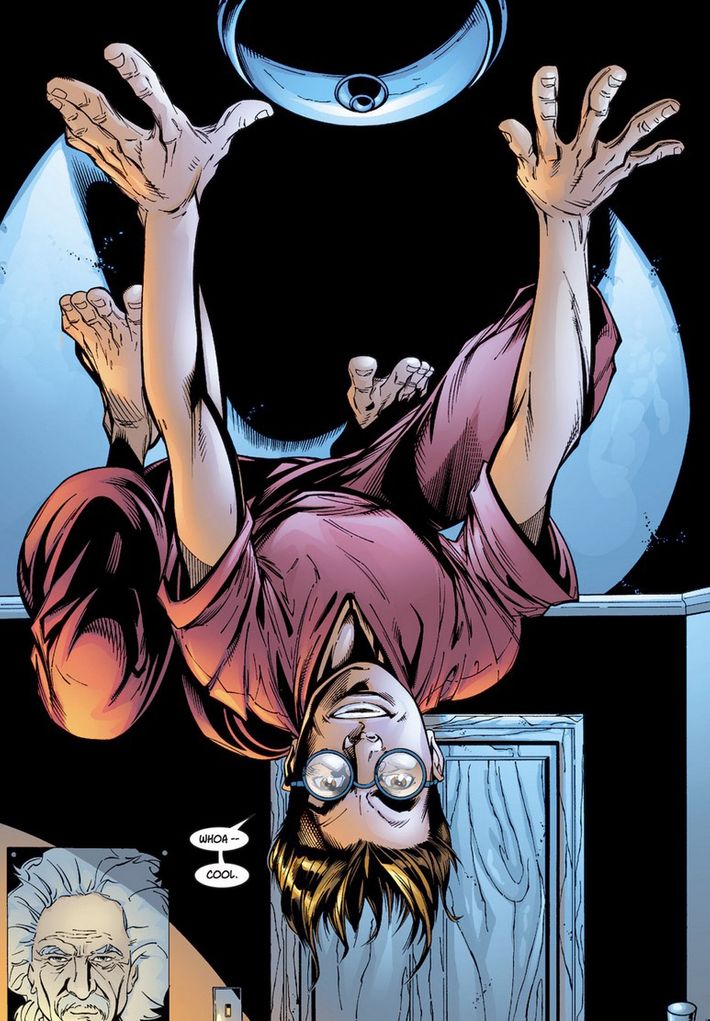
Jemas was overjoyed with the issue, but retailers were skeptical. “I publicly said, ‘If Ultimate Spider-Man made it to 100 issues, I would eat a bug,’” San Francisco–based comics-shop owner Brian Hibbs told me. The first issue debuted at No. 15 on the monthly sales charts for September of 2000, selling a modest 54,407 copies. But Jemas had a wild, risky scheme: He distributed millions of copies at chain stores like Payless Shoes and Walmart. Major media outlets picked up on Jemas’s publicity push, leading to glowing reviews (“One of the most emotionally resonant depictions of teendom in comics,” Entertainment Weekly wrote of the series). That all added up to overwhelmingly positive — and widespread — word-of-mouth praise. Sales steadily rose.
Finally, in December, the buzz paid off and Ultimate Marvel hit the top of the comics sales charts. But it wasn’t with Ultimate Spider-Man. The first megahit Ultimate comic was the first issue of Ultimate X-Men, which sold a staggering 117,085 copies that month. It was set in the same universe as Ultimate Spider-Man, and had been long delayed because Jemas and Quesada couldn’t decide on a writer. They tore their hair out during the search, even rejecting their beloved Bendis’s spec script for the series. The person they finally picked was a newcomer to Marvel with an extremely controversial reputation for his work at other publishers. He was a Scotsman named Mark Millar, and the work he created at Ultimate Marvel changed superhero fiction forever — for better or worse.
*****
The history of Ultimate Marvel is, in a way, a story about warring approaches to a reboot: Bendis’s and Millar’s. Bendis wanted to polish the old archetypes; Millar wanted to aggressively critique them. Bendis sought timeless stories; Millar craved biting contemporary political critique. Bendis was looking to inspire; Millar aimed to disquiet. As Bendis put it: “I’m writing about hope and he’s writing about nihilism, and I know he doesn’t always think he is, but he is. Constantly.”
Millar is one of the most divisive — and successful — names in the history of comics, and he had already begun his meteoric ascent when Quesada and Jemas snatched him up. At DC, he’d written jaw-droppingly violent and provocative stories on a series called The Authority. One Authority story was even about the titular superteam fighting an army of horrific pastiches of Marvel superheroes, including a rapist Captain America, a baby-murdering Iron Man, and white-supremacist X-Men. But he’d gone too far and left DC after they told him he couldn’t enact some of his more wild ideas (including George W. Bush authorizing the deployment of a government-created pedophile supervillain). As envelope-pushing as he was, Millar was also a brilliant crafter of action-story structure and — perhaps to a fault — knew how to grab attention unlike anyone else in the business. Jemas never shirked from controversy, and relished making this high-profile hire.
Millar’s initial stories for Ultimate X-Men may have sold like gangbusters in 2001, but they weren’t especially groundbreaking (other than the awful goatees that artist Adam Kubert gave to Wolverine and Cyclops). His greatest achievement was brewing in the background. Jemas and Quesada had asked him to team up with superstar artist Bryan Hitch for the launch of Ultimate Marvel’s take on Marvel Comics’ premier superteam, the Avengers. Hitch had drawn for The Authority (though his run didn’t overlap with Millar’s), where he earned a reputation for drawing comics that looked like movies: full of photorealistic figures and enormous action sequences. The Ultimate-universe Avengers series would be called The Ultimates, and Marvel wanted it to be the imprint’s biggest series yet.
“The tout of actually being able to make an Avengers film wasn’t on anybody’s radar,” Hitch told me. “So that’s what we said, that this was ‘Avengers: The Movie.’” They couldn’t have known how true that cheeky philosophy would turn out to be. In a scant few months, the pair unwittingly concocted ideas that formed the foundation of the worldwide-hit Marvel Cinematic Universe. As Joss Whedon, writer/director of The Avengers and its sequel, put it: “It’s my feeling that Ultimates brought Marvel into the modern age in a way no other book did.”
The Avengers that hundreds of millions of people see on the silver screen are, for the most part, the Ultimates. The classic Avengers were a private club that hung out in a mansion with a wacky butler; the Ultimates were a military operation assembled by superspy Nick Fury to combat extinction-level threats. Classic Hawkeye was a wisecracking reformed criminal who wore a ridiculous purple mask; Ultimate Hawkeye was a hardened black-ops soldier in dark leather who was best buddies with Black Widow. Classic Iron Man was a wealthy-but-sweet ladies’ man with a firm code of ethics; Ultimate Iron Man was a cynical, charismatic, womanizing alcoholic. Classic Nick Fury was white; Ultimate Nick Fury was African-American and explicitly drawn to look like Samuel L. Jackson (Millar had the idea to change Fury’s ethnicity, but Hitch was the one who modeled him off of Jackson, just because he thought the actor’s look fit their reimagined character’s attitude). Which of those setups sounds more familiar?
The reliably high quality and ever-increasing sales of the existing Ultimate Marvel series had built a fever pitch of buzz, so when The Ultimates No. 1 hit stands in January 2002, it flew off shelves and became the single best-selling comic of the year. “It wasn’t until The Ultimates came out that we recognized there was something legitimately big-time here with Ultimate,” retailer Hibbs recalled. And what made that success all the more remarkable was how outspokenly political and deconstructionist Millar’s story was. He knew there were unhealthy ideas at the core of the Avengers’ archetypes, and he was unafraid to prove it.
All of these Ultimate versions of the Avengers were, to put it bluntly, complete assholes. They were also all very specifically post-9/11 characters. Hawkeye and Black Widow were unfeeling government murderers, Iron Man was a gleeful war profiteer, and Captain America … well, Ultimate Captain America was just about the most blunt satire of War on Terror neoconservatism that popular culture had seen up until that point. He was a cold, stern prick in World War II, and when he was reawakened in 2002, he immediately felt an affinity for President Bush’s crusaderlike worldview. Indeed, the third issue literally concluded with Cap saluting President Bush. Later, in one of modern superhero comics’ most infamous moments, an alien invader tells Cap to surrender and he responds, “Surrender? SURRENDER??!!” and, pointing to his helmet’s giant A, “You think this letter on my head stands for France?”
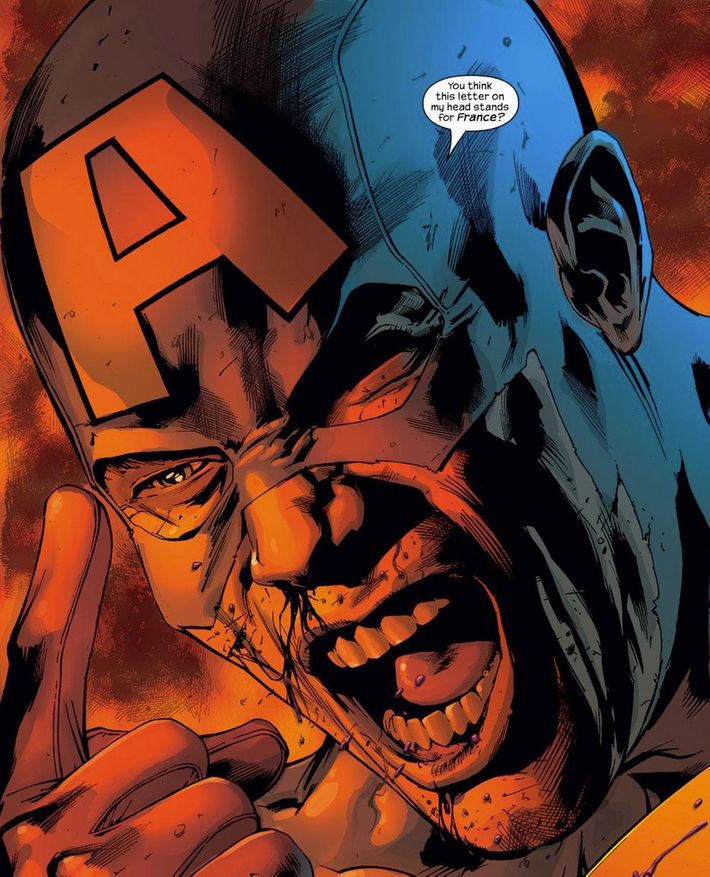
If you were a comics fan in 2002 and 2003, The Ultimates was all you and your friends could talk about. It was a panoramic action story that was thrilling in a way nothing else in comics was. And in retrospect, it’s astounding how leftist The Ultimates was, during a period when American action movies were either pro-war or purely escapist. Millar declined to be interviewed for this article, but I spoke with him at length two years ago for a profile I wrote at The New Republic, and he outlined his philosophy there. “Europeans tend to be pretty left-wing, and Scotland’s always been a left-wing country, so I’m always suspicious of uniforms,” the Scotsman said. But you didn’t have to be a liberal to love The Ultimates: It was a rip-roaring action story with luscious artwork, and even though Ultimate Cap wasn’t intended as a role model, many took him as such. “People would say, ‘I joined the army after reading The Ultimates because I wanted to make a difference in the Middle East,’ and I was like, ‘Well, I kinda meant the opposite of that,’” Millar recalled with a laugh.
By the middle of the decade, the Ultimate Marvel line was a wild success, regularly dominating best-seller charts. Ultimate Spider-Man, Ultimate X-Men, The Ultimates, and the newly launched Ultimate Fantastic Four all existed in the same universe, meaning the sleek, Ultimate versions of Marvel’s characters were all hanging out with one another in their own little pocket of fiction. Every week, readers would pick up issues of the Ultimate titles to see how the “Ultimized” versions of long-standing characters would fit into the Ultimate universe — a universe you could plausibly catch up on with just a few days of backissue reading. Marvel continued to publish dozens of series set in the old, mainstream universe — but the Ultimate universe was what fans and critics buzzed about.
“It really saved the industry at that time,” longtime comics journalist Heidi MacDonald said. “Ultimate [Marvel] reignited interest among Marvel fans and got new readers.” To bring some shine and excitement to its non-Ultimate universe, Marvel put Bendis and Millar in charge of mainstream Marvel titles like The Avengers and Wolverine as well. Marvel regained the top spot in market share, and Ultimate Marvel was the engine that drove it there. As Ultimate Fantastic Four writer Mike Carey put it, if you were an Ultimate writer, artist, or editor, you were in the “cool kids’ club.”
But there were cracks in the foundation, and they were widening. Jemas was ousted in 2004 after a string of high-publicity publishing flops — some related to Ultimate Marvel, some tied to mainstream Marvel. The second volume of The Ultimates began in 2005 and was perpetually delayed due to Hitch’s agonizingly slow artistic process, infuriating fans and retailers. Aging sci-fi writer Orson Scott Card wrote a reviled Ultimate Iron Man miniseries. On top of all that, Marvel was simply running out of characters to Ultimize. To keep this massive reboot effort relevant, Quesada needed something big to get readers excited again, so he and longtime superhero writer Jeph Loeb concocted a major story to shake up the Ultimate line. What they created was one of the biggest creative disasters in comics history, one from which Ultimate Marvel never quite recovered.
****
Millar left the Ultimate line after Ultimates 2, but Quesada and Loeb opted to take Millar’s sexed-up, ultraviolent, transgressive techniques and amplify them. Loeb launched Ultimates 3 in 2007, and in the very first panel, the Ultimates are watching a sex tape of Iron Man and Black Widow. A few pages later, brother-and-sister heroes Quicksilver and Scarlet Witch are caught in an incestuous tryst — and just a few pages after that, Scarlet Witch is brutally murdered in broad daylight. That kind of random sex and violence was rampant throughout the third Ultimates outing, without the political relevance or epic pacing of the first two volumes. Sales were good, but reviews were terrible.
As it turned out, it was all just a prologue for Ultimatum, a 2008 miniseries that would irreparably damage the Ultimate universe. When artist David Finch was recruited to draw for it, Marvel gave him a very simple description of the story’s mission. “I was told it was a way to basically kill everyone in the Ultimate universe,” Finch told me. “And that’s pretty much what it turned out to be.”
That’s a bit of an exaggeration, but not by much. Loeb later told Newsarama.com that Ultimatum was always intended to be “a big, blockbuster-y kind of thing,” “a big, noisy, disaster story about a massive change in the Ultimate Universe,” and “very much a Michael Bay movie.” Indeed, in the Michael Bay tradition, the story begins with Magneto using a tidal wave to kill nearly everyone in Manhattan. But even Bay might have blushed at Ultimatum’s subsequent violence. Over the course of just five issues, 34 different heroes and villains were murdered, often by gruesome means: Doctor Strange was squeezed until his head exploded; Magneto was decapitated; the Blob ate the Wasp and, while holding her half-devoured corpse, belched out, “Tastes like chicken”; and so on. It was an abattoir masquerading as a comics series, filled with anatomically improbable breasts and laughable dialogue. (I reached out to Loeb for an interview but was told he would only speak with me if we didn’t discuss Ultimates 3 or Ultimatum.)
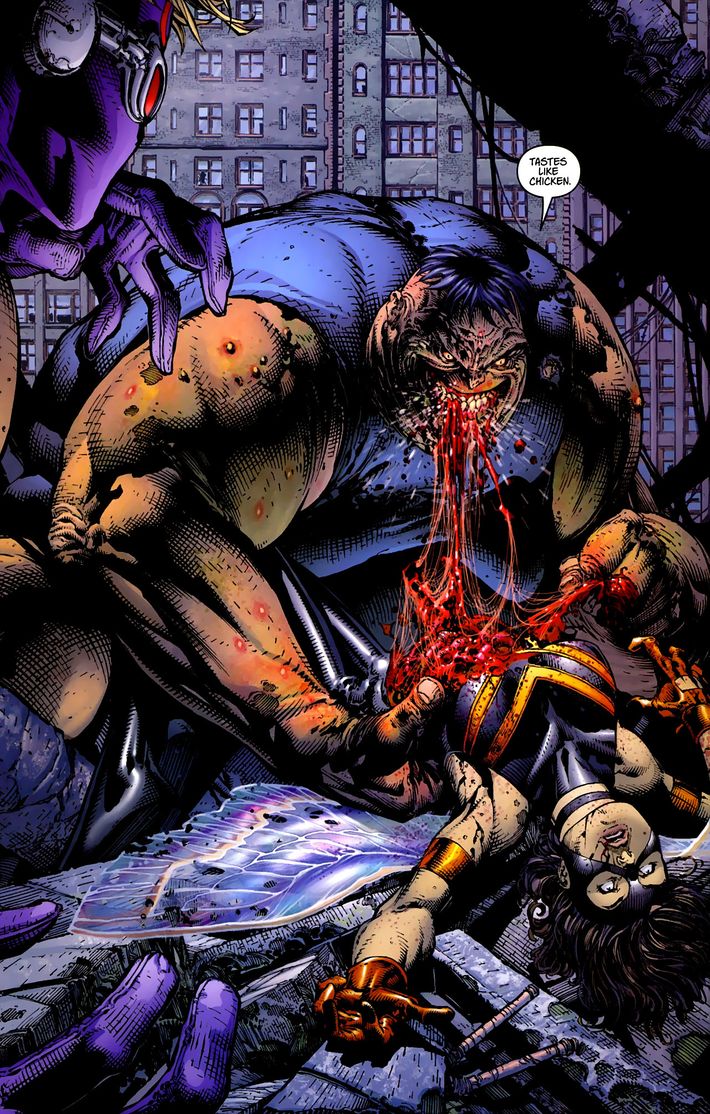
Fans and retailers were furious. “It was fucking terrible,” retailer Hibbs recalled, adding that he was only able to sell about half of the copies he ordered for his store. “Ultimatum is a base and insulting comic book,” read a review at comics site Let’s Be Friends Again. “Ultimatum #5 could quite possibly be the single worst piece of writing in recorded history,” wrote critic Jason Kerouac. But Jesse Schedeen of IGN most succinctly summed up the damage Loeb and Quesada had done to the Ultimate Marvel experiment: “I sincerely hope the Ultimate line is able to return to its roots and offer readers clean, accessible, and unique takes on these iconic heroes again,” he wrote. “It had better, because I’m growing dangerously close to wiping my hands of the whole enterprise.” He wasn’t alone in his disdain: Overall sales for the Ultimate line never returned to their pre-Ultimatum levels.
But just as the Ultimate comics reboot was faltering, the ideas it had spawned in the pre-Ultimatum years were succeeding elsewhere — specifically, on the big screen. In 2005, Marvel announced plans to start producing its own movies (hits like Spider-Man and X-Men had been produced by Sony and Fox, respectively), and its first offering was going to be an Iron Man film. Millar and Bendis were brought on as consultants, but even without their help, the filmmakers had decided to have Robert Downey, Jr. play the Ultimate take on Tony Stark: a skeezy, boozed-up prick whom you still couldn’t help rooting for. But the coup de grâce was the much-talked-about post-credits scene, co-written by Bendis, in which Tony meets Nick Fury … as played by Samuel L. Jackson. It wasn’t even Bendis or Millar’s idea to bring Jackson-as-Fury to the big screen — producer Kevin Feige had loved Ultimate Nick Fury so much that he had reached out to Bendis. The movie was a smash, and a major vindication for the Ultimate Marvel experiment.
As Marvel’s movie empire grew, the Ultimate vision became a deeper and deeper influence. When Hawkeye showed up in Thor, he was a dead ringer for Ultimate Hawkeye. When Captain America debuted, he wasn’t a jerk like Ultimate Cap, but his costume was almost 100 percent lifted from Hitch’s Ultimate redesign. And when Ultimates superfan Joss Whedon crafted The Avengers (released in 2012), the whole endeavor ended up feeling like an Ultimate production — epic action sequences, military-sponsored missions, naturalistic dialogue — and almost nothing like the Avengers of old.
And in the world of comics, even though Ultimate sales were dropping throughout the late ‘00s, Marvel’s mainstream titles were doing quite well — largely because they had adopted many of the hallmarks of the Ultimate brand: a more realistic tone (well, as realistic as you can get in a world with telepaths and gods), sleek visual modernism, and a willingness to shake the status quo with operatic action. Mainstream Marvel heroes rarely pranced around in pastel leotards anymore, and they certainly didn’t have clunky internal monologues in thought bubbles: They looked and sounded more and more like their Ultimate-universe counterparts from the pre-Ultimatum years.
As an imprint, however, Ultimate Marvel simply couldn’t get back on track. Millar was brought back for a long run on Ultimates, but readers found the stories half-baked and dull. Up-and-coming writer Jonathan Hickman penned a major story about Ultimate Mr. Fantastic turning evil and destroying half of Europe — but simultaneously, DC Comics did a linewide relaunch that was, in essence, its own attempt to “Ultimize” its characters. (The DC push was an initiative called “The New 52,” in which the publisher canceled all its existing comics titles and rebooted its characters in stories where they were younger and freed from old continuity.) DC’s reboot (which is still ongoing) was a smash hit and drew attention away from Marvel’s Ultimate tales. Sales simply couldn’t perk up. What’s more, Millar became a reviled figure among progressive comics fans, known for his creator-owned Millarworld comics, in which grisly murder and obscene rape were regularly on tap. Superhero fans would joke about classic Ultimates scenes like Cap’s anti-France rant, dismissing them as cynical relics of a bygone era.
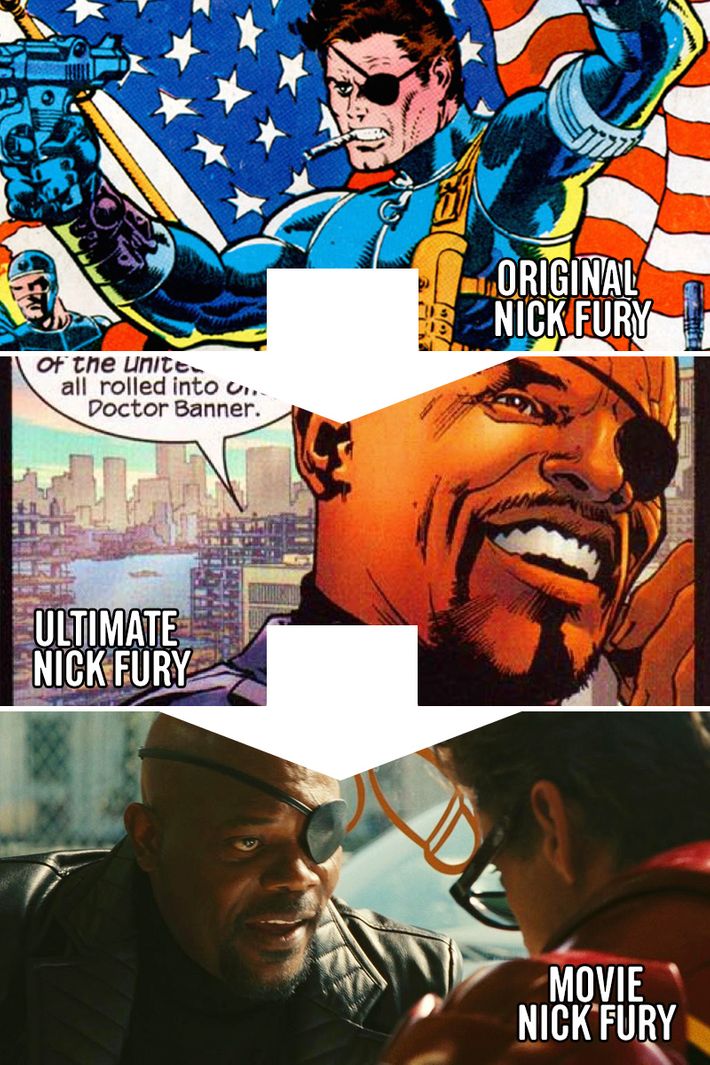
There was only one saving grace for the Ultimate universe and the promise it had once held: Bendis’s Ultimate Spider-Man stories. Bendis was Marvel’s golden boy, and although his stories acknowledged that Ultimatum happened, Quesada never forced him to change the optimistic tone of his beloved series. Sales were never spectacular, but they were solid and dependable. Indeed, Bendis and series artist Mark Bagley broke the record for longest-running unchanged creative team on a comic — and when Bagley left after issue No. 111, Bendis kept plugging along. But the series’ greatest achievement came in 2011, when Bendis introduced a new character, one who represented the triumph of the Bendis approach to a reboot: finding hope and light in Marvel’s core principles. The character’s name was Miles Morales, he was Afro-Latino, and he will almost certainly be Ultimate Marvel’s most lasting legacy in the world of superhero comics.
****
Bendis wasn’t blind. He knew that by 2011, the decade-long Ultimate experiment had lost much of its luster. He was constantly talking to colleagues about how to fix the world he’d launched. “I would say, ‘Hey, what did we do right? What did we do wrong? What would I have done differently?’” he recalled. “In those conversations of what we did right or wrong, we’d come about the idea of Peter Parker being of a different race. That if you really look at the origin, there’s no reason that character wouldn’t be of color. In fact, maybe it makes more sense.”
He soon became fixated on the racial questions posed by the Spider-Man archetype. If a middle-class teenager was growing up deep in Queens in 1962, sure, he’d be white. But in the New York of 2011’s profoundly multiethnic outer boroughs? Statistically, he’d almost certainly be a person of color. But if Bendis was going to introduce a nonwhite Spider-Man, what would he do with the existing Spider-Man? That’s where the magic of the anything-is-possible Ultimate Marvel approach paid off.
“We started thinking about who ended up being Miles, and it became obvious that the only way Miles works is if Peter isn’t there,” Bendis said. “Then you realize that the trigger has to be pulled.” Bendis wrote a story in which Ultimate Peter dies a hero’s death. Around the same time, shy teenager Miles Morales gains similar abilities to Peter’s and tentatively starts fighting crime in his stead. The ensuing story lines were classic Bendis: tender, streamlined, and optimistic. Miles wasn’t just an Afro-Latino Peter Parker. He was his own person, kind and quiet, reluctant to stand out and perpetually struggling with self-doubt — in many ways, an even more believable teenager than Ultimate Peter had been.
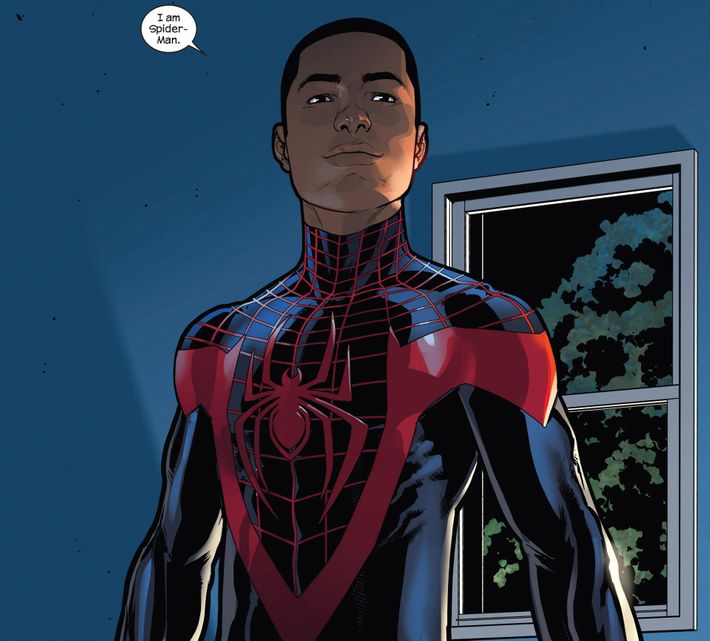
Miles was also an enormous hit immediately after his August 2011 debut. Sales for the series spiked, but more important, Miles was a publicity sensation, drawing attention in mainstream media outlets and among fans who had long ago grown bored with Spider-Man. Just a few months into his existence, long before Marvel had made any Miles merchandise, fans were constructing their own Miles costumes (his uniform has a slightly different color scheme than Peter’s) and wearing them to conventions. Marvel knew it had a hit on its hands, and has recently started cranking out Miles costumes, Miles toys, and a version of Miles in the hit Saturday-morning Spider-Man cartoon. When Sony announced it was rebooting its Spider-Man movie franchise yet again, there were cries across the internet for the new Spidey to be Miles. “Miles was something that was vital and important, and he sold,” Hibbs said. “It brought a lot of attention back to that book. But it didn’t help the entire line.”
Nothing could save the rest of the Ultimate line, which had larger problems than just the fallout from Ultimatum. More than a decade into the Ultimate project, Marvel had learned a harsh lesson about the concept of a franchise reboot: It tends toward chaos. If a new reader tried to digest an issue of an Ultimate comic in 2011, she’d run into the exact problem Ultimate Marvel was designed to combat: confusing continuity. Wait, why was Mr. Fantastic evil? What had happened four years ago in Ultimatum? Remind me how Dr. Doom died? As Hickman put it: “I think maybe the lesson might be that continuity eventually swallows everything.” (Incidentally, now that the Marvel Cinematic Universe is 11 movies deep, this is becoming a concern for Marvel Studios. It remains to be seen how Marvel’s movie producers might learn from the pitfalls of the Ultimate world.)
Creators and editors I spoke to said the decision to kill the Ultimate brand came sometime in 2013. There was a last-ditch Ultimate story that year, entitled Cataclysm, where a cosmic entity came to devour the Earth. Then-writer of Ultimates Joshua Hale Fialkov told me the writing was on the wall: “The way it was put to me was, we need to do something gigantic,” he said, “but if it didn’t raise the profile of the universe, then they’d end it.” It was a sales failure. The trigger had to be pulled.
****
To Marvel’s credit, the Ultimate universe is getting a Viking funeral. There has been a years-long story line in the mainstream Marvel universe, written by Hickman, which has climaxed in a massive crossover event called Secret Wars. The catalyst, seen in this month’s Secret Wars No. 1, is an interdimensional apocalypse in which the Ultimate universe and the mainstream Marvel universe literally collide, destroying each other. At the end of the issue, a sparse page features text reading “THE MARVEL UNIVERSE • 1961 - 2015” and “THE ULTIMATE UNIVERSE • 2000 - 2015.” This is, however, a bit of a misdirect: Marvel has already announced plans for its post–Secret Wars status quo, which appears mostly to be a reconstruction of mainstream Marvel (it remains to be seen how much of this new status quo will be a reboot of its own). The only real death here is an Ultimate death.
All is not lost. Marvel has also made it clear that the new status quo will feature some as-yet-unspecified synthesis of the two universes. We do have confirmation that Miles Morales will join the Avengers, which is a huge victory both for diversity and for the legacy of the Ultimate experiment. And in the world of the movies, African-American Nick Fury isn’t going anywhere, nor is asshole Tony Stark or leather-loving Hawkeye. Plus, this summer’s Fantastic Four movie is explicitly an homage to Ultimate Fantastic Four: Its titular heroes will all be youngsters, an innovation concocted in the Ultimate universe.
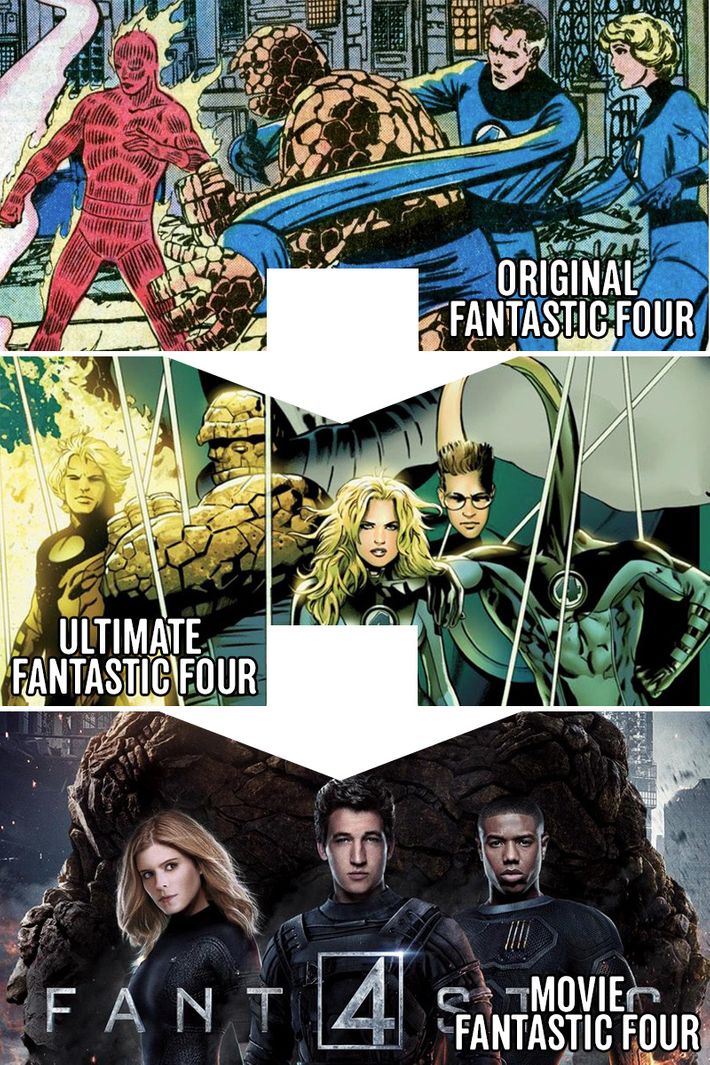
And that gets at the other big lesson of the Ultimate experiment: If a reboot succeeds, it bleeds into the world around it — often to its own detriment. “The biggest frustration with me was that the things that made the Ultimate universe so special were applied to the regular Marvel universe, making the Ultimate universe less special,” Bendis said. In other words: Ultimate Marvel was so successful that it made itself unnecessary. As long as Miles is saved (and, perhaps, Ultimate Nick Fury), nothing very beloved will be lost in the death of the once-sensational Ultimate universe. All the themes and motifs have, thankfully, sprouted across the superhero genre and brought it to unheard-of heights of success.
There’s one final lesson. According to Bendis — the alpha and omega of Ultimate Marvel storytelling — the key to the reboot was understanding what made the old Marvel archetypes worth rebooting in the first place. “The transition that we made was based on the fact that the concept of Spider-Man wasn’t broken,” he told me. “The Spider-Man origin and its themes are pretty much perfect. So adaptations are much like a Shakespeare play: The trick isn’t to fix it and say you know better than Shakespeare. It’s to find the truth of it and keep the truth going for a new audience.”

